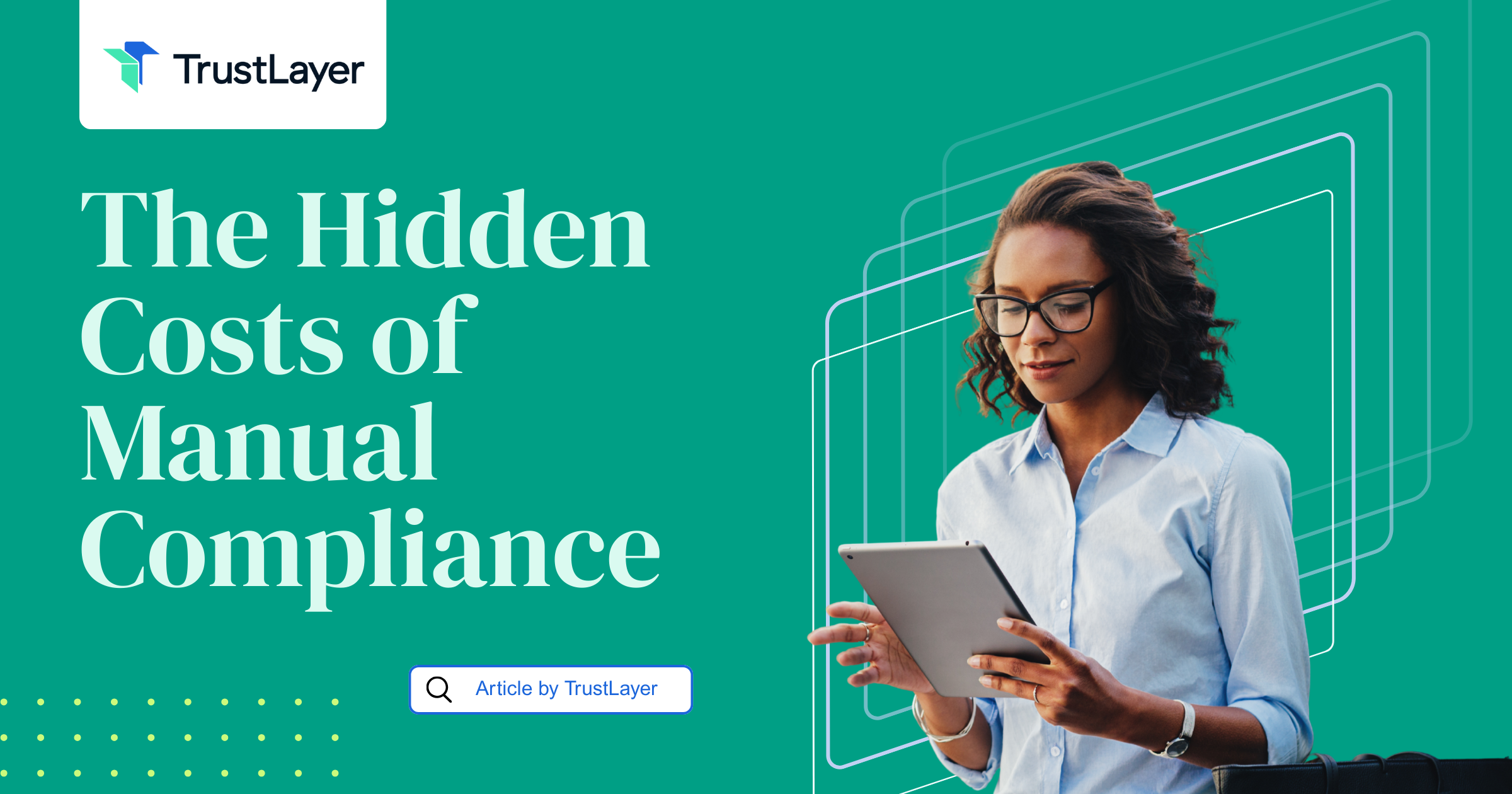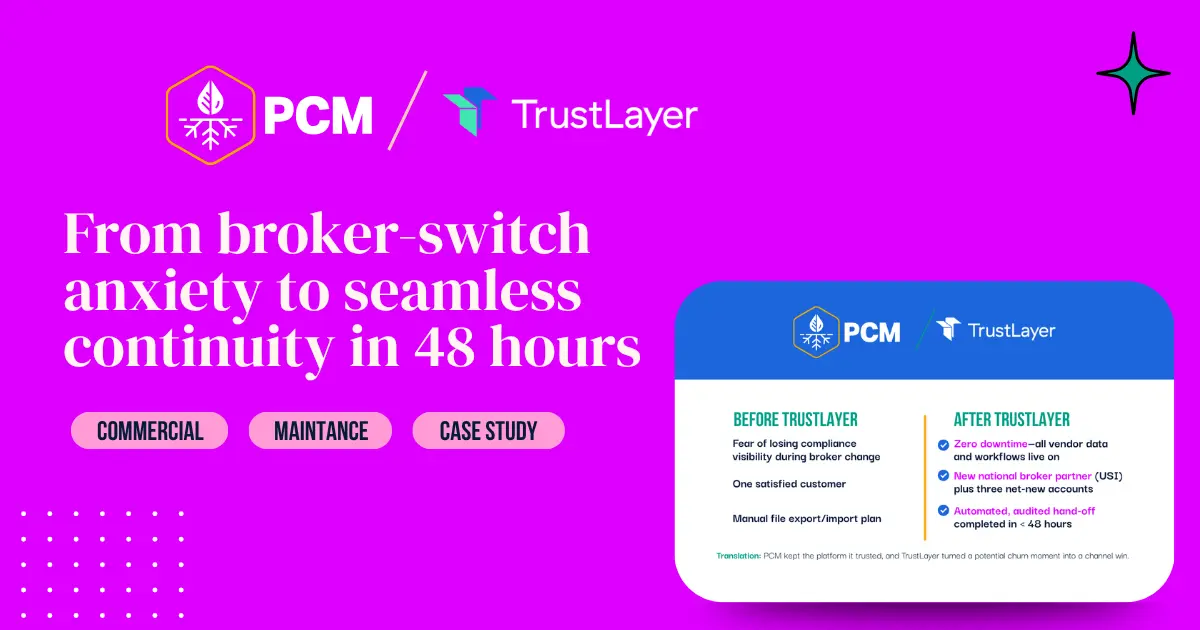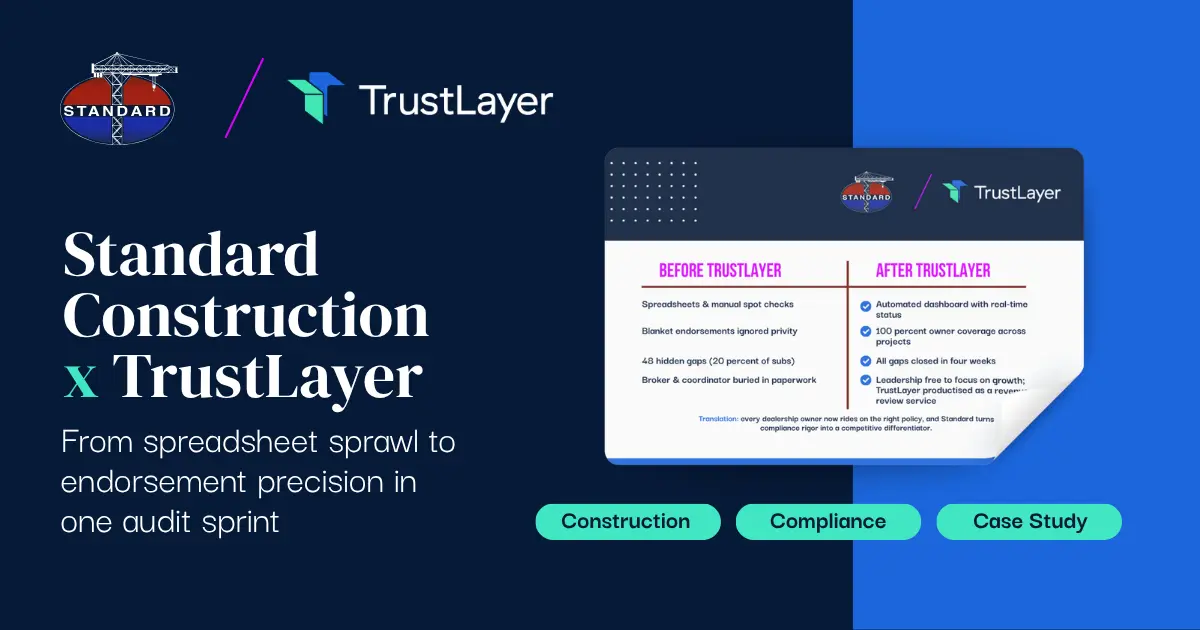Streamlining Compliance With Digital COI Management

In the fast-paced world of business, compliance is a crucial component that ensures organizations adhere to legal and ethical standards. For years, companies have grappled with the challenges of managing compliance effectively, often being burdened by manual processes and outdated systems. However, the rise of digitalization has paved the way for a more streamlined approach to compliance, particularly when it comes to managing Certificates of Insurance (COI).
Understanding the Importance of Compliance in Business
Compliance is not just a buzzword; it is a critical aspect of risk management in any organization. Effectively managing compliance helps businesses mitigate potential risks, avoid legal consequences, and safeguard their reputation. Compliance measures encompass a wide range of areas, ensuring that companies adhere to laws, regulations, industry standards, and internal policies.
When it comes to compliance, it is essential to understand its role in risk management. Risk management is an integral part of any organization's strategy, as it focuses on identifying, assessing, and mitigating potential risks. Compliance plays a pivotal role in this process by implementing controls and procedures that minimize the likelihood of risks materializing. By streamlining compliance, businesses can proactively manage and reduce risks, creating a more secure operating environment.
Moreover, the legal implications of non-compliance cannot be overlooked. The consequences of non-compliance can be severe, posing significant threats to a company's sustainability. Organizations that fail to comply with legal and regulatory requirements may face hefty fines, legal proceedings, reputational damage, and even the suspension of operations. In highly regulated industries such as finance, healthcare, and insurance, the impact of non-compliance can be particularly detrimental.
For example, in the finance industry, non-compliance with financial regulations can result in severe penalties, loss of customer trust, and damage to the overall stability of the financial system. In the healthcare sector, non-compliance with privacy and data protection laws can lead to breaches of patient confidentiality, compromising the trust between healthcare providers and patients. Similarly, in the insurance industry, failure to comply with regulations can result in the denial of claims, legal disputes, and a tarnished reputation.
Therefore, it is imperative for companies to prioritize compliance to protect their interests and ensure long-term sustainability. Compliance should not be viewed as a burdensome obligation but rather as an opportunity to enhance business practices, build trust with stakeholders, and maintain a competitive edge in the market. By investing in robust compliance programs, organizations can demonstrate their commitment to ethical conduct, responsible governance, and the well-being of their employees, customers, and the wider society.
Defining Digital COI (Certificates of Insurance)
Certificates of Insurance (COI) are documents issued by insurance providers as proof of insurance coverage. They detail essential information, such as policy numbers, coverage limits, and effective dates. Traditionally, managing COIs involved a cumbersome process, with organizations manually collecting, verifying, and tracking COIs. However, digitalization has revolutionized COI management, simplifying the process and improving compliance efficiency.
The Evolution of COI Management
Historically, COI management relied on paper-based records and manual verification processes. This approach was time-consuming, prone to errors, and made it challenging to track and monitor compliance effectively. Organizations had to dedicate significant resources to physically storing and organizing COIs, often resulting in misplaced or lost documents.
However, with the advent of digital COI management tools, organizations can easily store, access, and validate insurance information. These tools provide a centralized repository for COIs, eliminating the need for physical storage and reducing the risk of document loss. Moreover, digital platforms offer advanced search and retrieval capabilities, allowing organizations to quickly locate specific COIs when needed.
Furthermore, digitalization has streamlined the verification process. Instead of manually reviewing each COI, organizations can leverage automated systems that validate insurance information against predefined criteria. This automation not only saves time but also minimizes the risk of human error, ensuring accurate and reliable verification.
The Impact of Digitalization on COI
Digitalization has brought numerous benefits to COI management. With digital tools, organizations can automate the process of collecting and verifying COIs, reducing the risk of errors and ensuring up-to-date information. This automation extends to the communication between insurance providers and organizations, enabling seamless exchange of COIs and updates.
Additionally, digital platforms enable real-time tracking and monitoring of insurance certificates, ensuring compliance across the entire organizational ecosystem. Organizations can set up alerts and notifications to stay informed about expiring policies or coverage changes. This increased visibility and transparency allow businesses to proactively address compliance issues and avoid potential risks.
Moreover, digital COI management tools often come with reporting and analytics capabilities. Organizations can generate comprehensive reports on COI compliance, identifying trends and patterns that can inform risk mitigation strategies. These insights enable organizations to make data-driven decisions and optimize their insurance coverage based on historical data.
Furthermore, digitalization has facilitated seamless integration with other business systems. COI information can be easily integrated into procurement, vendor management, or risk management systems, ensuring a holistic approach to compliance. This integration eliminates silos and promotes cross-functional collaboration, enhancing overall efficiency and effectiveness.
In conclusion, the digitalization of COI management has revolutionized the way organizations handle insurance information. From eliminating manual processes to improving compliance tracking and reporting, digital tools have significantly enhanced efficiency and reduced risks. As technology continues to advance, the future of COI management holds even more possibilities for streamlining processes and optimizing risk management strategies.
The Intersection of Compliance and Digital COI
When it comes to managing compliance, the intersection of traditional compliance processes and digital COI has become a focal point for organizations seeking streamlined solutions.
Compliance is a critical aspect of any organization's operations. It ensures that businesses adhere to laws, regulations, and industry standards, mitigating risks and maintaining ethical practices. However, managing compliance can be a complex and time-consuming task, especially when it comes to managing conflicts of interest (COI).
COIs arise when an individual or entity has competing interests that could compromise their ability to act impartially. These conflicts can create ethical dilemmas and potential legal liabilities. Traditionally, organizations relied on manual processes to identify, verify, and manage COIs. However, these practices have long been plagued by inefficiencies and limitations.
The Challenges of Traditional COI Management
Traditional COI management practices have long been plagued by inefficiencies and limitations. Manual processes were time-consuming, often resulting in delays and administrative burdens. Verifying and updating COIs required significant manpower, leading to increased costs and the potential for oversight. These challenges underscore the need for a more automated and digital approach to COI management.
With manual COI management, organizations faced the risk of overlooking or missing critical COIs. The sheer volume of COIs to be managed, especially in large organizations, made it difficult to keep track of all potential conflicts. This lack of visibility could expose businesses to reputational damage, legal consequences, and financial losses.
Furthermore, the manual nature of COI management made it challenging to ensure accuracy and consistency. Human errors, such as data entry mistakes or misinterpretation of COI policies, could lead to incorrect assessments and ineffective mitigation strategies. These errors not only undermined the integrity of the compliance process but also increased the risk of non-compliance.
The Benefits of Digital COI for Compliance
Digital COI solutions offer a range of benefits essential for efficient compliance management. These tools automate COI verification and tracking, reducing manual errors and ensuring accuracy. By centralizing COI data on a secure digital platform, businesses gain real-time insights into compliance status and can proactively address any deficiencies. Furthermore, digital COI tools facilitate collaboration between stakeholders, enabling seamless communication and timely compliance updates.
One of the key advantages of digital COI solutions is the ability to automate the verification process. These tools can integrate with external databases and sources to quickly identify potential conflicts. By leveraging technology, organizations can save time and resources that would otherwise be spent on manual verification.
Another benefit of digital COI solutions is the improved visibility they provide. With a centralized digital platform, organizations can easily access and analyze COI data. Real-time dashboards and reports enable stakeholders to monitor compliance status, identify trends, and take proactive measures to address any issues. This enhanced visibility not only improves decision-making but also helps organizations demonstrate their commitment to compliance to regulators, clients, and other stakeholders.
Collaboration is crucial in managing COIs effectively. Digital COI tools facilitate seamless communication and collaboration between different stakeholders, such as compliance officers, legal teams, and employees. These tools enable the sharing of COI information, updates, and mitigation strategies in real-time, ensuring everyone is on the same page and can work together to address potential conflicts.
In conclusion, the intersection of compliance and digital COI offers organizations a more efficient and effective way to manage conflicts of interest. By embracing digital solutions, businesses can overcome the challenges of traditional COI management and reap the benefits of automation, accuracy, visibility, and collaboration. As compliance requirements continue to evolve, organizations must adapt and leverage technology to ensure they meet their obligations and maintain the highest standards of integrity.
Implementing Digital COI for Streamlined Compliance
Transitioning to digital COI management requires careful planning and execution. Organizations must consider the following steps to ensure a successful implementation:
First and foremost, it is important to understand the significance of digital COI tools in streamlining compliance processes. These tools offer a range of key features that can revolutionize the way organizations manage their certificates of insurance (COI).
Key Features of Digital COI Tools
- Automated COI Verification: Digital COI tools utilize automation and artificial intelligence to accurately validate insurance information, minimizing the risk of errors and omissions. This advanced technology ensures that COIs are verified quickly and accurately, saving organizations time and effort.
- Real-time Monitoring: With digital COI solutions, businesses can track the compliance status of vendors, contractors, and suppliers in real-time, ensuring continuous adherence to insurance requirements. This real-time monitoring capability allows organizations to proactively address any compliance issues and avoid potential risks.
- Secure Document Storage: Digital platforms provide a secure and centralized repository for storing COI documents, eliminating the need for physical storage and reducing the risk of loss or damage. These platforms often offer robust security measures, such as encryption and access controls, to ensure the confidentiality and integrity of stored documents.
Now that we have explored the key features of digital COI tools, let's delve into the steps involved in transitioning to a digital COI management system.
Steps to Transition to Digital COI
- Evaluate Current Processes: Organizations should assess their existing COI management processes and identify pain points that can be addressed through digital solutions. This evaluation helps organizations understand the specific challenges they face and determine the features and functionalities they require in a digital COI tool.
- Select the Right Provider: Choosing the right digital COI provider is crucial for successful implementation. Organizations should consider factors such as reliability, ease of use, customer support, and scalability. It is important to partner with a provider that understands the unique needs of the organization and can offer a solution that aligns with its goals and objectives.
- Implementation and Training: Once a digital COI solution is selected, organizations must plan and execute a seamless transition, ensuring that employees are trained to effectively utilize the new system. This includes providing comprehensive training sessions and resources to familiarize employees with the features and functionalities of the digital COI tool.
- Migrate and Validate Data: Organizational COI data should be migrated into the digital platform, with thorough validation to ensure accuracy and completeness. This process involves transferring existing COI records into the digital system and verifying the information to avoid any discrepancies or missing data.
- Continuous Improvement: Implementing digital COI management is an ongoing process. Organizations should regularly evaluate the effectiveness of the solution and make adjustments as necessary. This includes gathering feedback from users, monitoring system performance, and identifying areas for improvement to ensure the digital COI tool continues to meet the organization's evolving needs.
By following these steps, organizations can successfully implement digital COI management and streamline their compliance processes. Embracing digital solutions not only enhances efficiency and accuracy but also reduces the administrative burden associated with traditional COI management methods.
Measuring the Success of Digital COI Implementation
Implementing digital COI brings forth the opportunity to measure the success and impact of streamlined compliance. Organizations can assess the efficiency and effectiveness of their compliance management by considering the following metrics:
Metrics for Evaluating Compliance Efficiency
- Time Savings: Measure the time saved in the COI verification and tracking process, comparing it to manual or traditional methods.
- Error Reduction: Evaluate the reduction in errors and omissions related to COI management, leading to improved accuracy and compliance.
- Cost Reduction: Assess the cost savings achieved through a more efficient and automated COI management process.
Continuous Improvement in Digital COI Management
Digital COI implementation is not the end of the journey; rather, it is the beginning of continuous improvement. Organizations should strive to enhance their compliance management by leveraging data analytics, artificial intelligence, and automation. By embracing technological advancements, businesses can stay ahead of regulatory changes, manage risks effectively, and optimize compliance outcomes.
Streamlining compliance with digital COI is a game-changer for organizations seeking to revolutionize their compliance management processes. By embracing digital tools, businesses can save time, reduce costs, and enhance overall compliance efficiency. TrustLayer, a leading digital COI management platform, offers a comprehensive solution that automates the collection, verification, and tracking of COIs. With TrustLayer, businesses can navigate the complex compliance landscape with ease and confidence, ensuring a seamless and compliant operating environment.
In conclusion, digital COI has emerged as a vital component in streamlining compliance. Its impact on risk management, automation benefits, and efficiency enhancement cannot be overstated. As companies strive for compliance excellence, digital COI tools provide the necessary foundation for success in the modern business landscape.
















